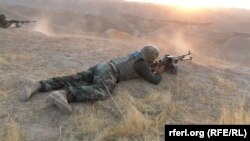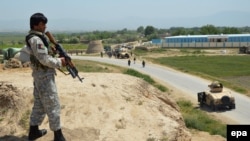It is barely six months since the official end of the drawdown of foreign combat forces from Afghanistan. In those months, the situation in northern Afghanistan, in the provinces bordering Central Asia, has drastically deteriorated.
It is a nightmare scenario for the governments of Central Asia, who have been worrying about their own security since the announcement of the drawdown and are now watching as districts near their borders are being overrun. Adding to these concerns is the prominent role that militants from Central Asia have reportedly been playing in these assaults on Afghan government forces.
Afghan officials are now calling on Central Asian governments for more help, even weapons, so Afghan forces can better contain the threat.
RFE/RL’s Turkmen Service, known locally as Azatlyk, assembled a panel to discuss recent developments in northern Afghanistan and what Central Asia could do to help the Afghan government and military.
Azatlyk Director Muhammad Tahir moderated the discussion. Participating were Afghan member of parliament Kamal Safi; the director of Radio Mashaal (RFE/RL’s Pashto service) Amin Mudaqiq; and an RFE/RL correspondent who recently returned from northern Afghanistan, Frud Bezhan. I made some comments, too.
There are eight Afghan provinces bordering Central Asia. Bezhan was just in Balkh Province, which he described as “the last oasis of peace in the entire region.” But even there, Bezhan said, “We spoke to a lot of tribal elders, religious figures from the different districts around Balkh, and even there, there is increasing violence.”
Safi made the point that there is war throughout Afghanistan and the north is no exception. Mudaqiq said it would be incorrect to say fighting “has spread” to northern Afghanistan; rather it has “intensified.”
Part of the reason for that is the influx of “foreign” militants originally from Central Asia, members of the Islamic Movement of Uzbekistan (IMU), who have been chased from the safe havens in North Waziristan by the Pakistani military’s operation there.
Speaking about the Faryab Province that borders Turkmenistan, Mudaqiq said, “There was a statement from the Afghan commanders [on July 7] that the foreign militants are in charge. Actually, just as a matter of formality, they use the name of Taliban; but in reality they are the people who are calling the shots.”
Safi concurred, saying, “The foreign troops have command, the battlefield command in their hands most of the time.” He added, “They have brainwashed the people, even the local militants as well and...they have encouraged the local militants and they have increased the volume of the war in these areas.”
Safi also said part of the reason these Central Asian militants had been so successful was due to the marginalization of the Pashtuns in northern Afghanistan.
“They have no part in the national forces, the security forces, when they have no part in the other government administration, they have no part in the judiciary ... [and] they don’t think their part in the system matters.”
Bezhan said another part of the problem might be Afghan government neglect in the north. Mudaqiq suggested such neglect was evident in the distribution of military resources to the region: “For the whole north, I mean [north] of Hindu Kush, from Badakhshan up to Faryab there is only one division, while in Kandahar and Helmand there are two divisions.”
Mudaqiq noted that division had been moving almost constantly between battlefields in Badakhshan and Kunduz provinces in the east to Jowzjan and Faryab in the west.
At the end of June, Afghan Interior Minister Nur ul-Haq Ulumi confirmed the presence of Central Asian militants in northern Afghanistan. “The latest news I receive from northern Afghanistan is this: that the foreign-linked militants have settled down with their families in the region. It's probably because they speak the same language, but more important is that they really want to influence our neighbors in the north,” he said.
Ulumi made an appeal to Central Asia: “So far the people of Afghanistan have protected you. We do not want that our territory to be used against any of our neighbors but please give us your resources, equipment, things like mine exploding devices, scanners to check cars...”
LISTEN: An audio version of this roundtable
It was suggested there was little chance any of the Central Asian governments would part with any of their weapons or equipment, preferring to have them available for their own armies and security services.
It was also noted that prior to the arrival of foreign troops in Afghanistan in late 2001, the Central Asian governments had been very cautious in relations with any Afghan group so as not to be too bound to a losing side.
That said, the Uzbek and Tajik governments did support their ethnic cousins guarding the gateways to Central Asia -- General Abdul Rashid Dostum in Uzbekistan’s case, and Ahmad Shah Masud in Tajikistan’s case.
Mudaqiq said one useful thing the Central Asian governments could do would be to avoid repeating such cooperation. “The most important help the Central Asians can give is not to support their own proxies -- let the Afghan government take initiatives, because if they [Central Asian governments] do, then they antagonize the other tribes.”
But it might be equally problematic to try to fence off the border in an effort to contain Afghanistan’s problems and hope there will be no spillover.
Safi said it was clearly in Central Asia’s best interest to help the Afghan government to combat the security threat in Afghanistan. “It’s a common problem in the area,” he said, adding, “Terrorism affected Pakistan, terrorism affected Afghanistan, and it looks like terrorism in the area will affect Central Asia as well.”
The discussion looked at many other details and delved deeper into questions, such as the motives of the foreign fighters in northern Afghanistan, the lack of coordination among Afghan government and pro-government forces, and the role of outside “stakeholders” in this recent spike in violence south of Central Asia’s border.







